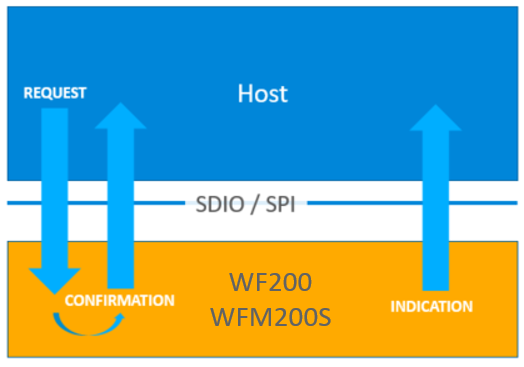API messages
Protocol
WF200 uses a classic request/confirmation and indication protocol to communicate with the host as shown below.

HOST to WF200
A message sent by the host is a request and is always answered back with a confirmation . This confirmation systematically informs the host of the status of the request .
WF200 to HOST
On top of sending back confirmations, WF200 is sending indication messages (e.g. packet reveiced, connection established...). The host is notified through an interrupt that information is available. Depending on the configuration register setting, the interrupt is issued on the standard GPIO (GPIO 29 wf200_hardware) or on WIRQ pin (pin 24).
Message header format
Message header is a 32bit word starting every messages sent or received by WF200. Below is a diagram to present the header content.

- Message length (16 bits): the size of the message including the header size.
-
Message info (16 bits): content below
- MsgId (8 bits): message ID, refer to requests , confirmation or indications for the ID values.
-
MsgInfo (8 bits): content below
- Reserved (1 bit)
- IntId (2 bits): Interface concerned by the message. For the FMAC driver, station interface is 0 and softap is 1.
- Reserved (3 bits)
- SecLink (2 bits): Always 00 for non-encrypted messages. In secure link mode, the standard header is replaced by a specific one.
The structure used to describe the message header can be found in the firmware header file in HiMsgHdr_t .